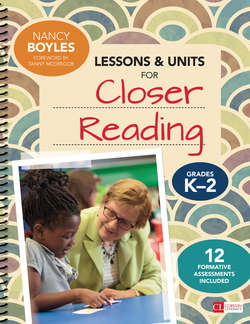Читать книгу Lessons and Units for Closer Reading, Grades K-2 - Nancy Boyles - Страница 51
На сайте Литреса книга снята с продажи.
How to Use the Active Reader Cards
Оглавление1 Photocopy and cut apart the Active Reader Cards: Noticing Key Details and provide one card to each student at the outset of an initial close reading lesson. Alternatively, you could display the poster-size image of the magnifying glass retrieved from the companion website (http://resources.corwin.com/boyleslessons/k-2.htm).
2 Tell students this is their “magic magnifying glass” and it will help them spot important clues in the text to help them understand it better. Point out some helpful clues to notice: something that’s new (additional information they may be getting about a character, the problem, or in informational text; something they didn’t know before), something that’s surprising, or something that’s confusing. They may notice other details they’d like to share, as well.
3 When you pause your reading after each chunk of text, invite students to share a detail they’ve noticed before launching into the text-dependent questions designated for that part of the text. As students become better at observing key details, they’ll likely address many of the points in your questions before you even have to ask them. (Note that this recommendation, to have students share their own details before you ask specific questions, is specified on all planners for the Initial Close Reading Lesson at the top of the “During Reading” section.)
4 As you respond to students’ observations, ask them to go a little deeper: Was this a detail that was new, surprising, or confusing? How does this detail help them understand the story or information better? (They might say something like “Now I know more about this character. I can picture that she is a bully.” Or, “I was confused at first. I was wondering what that animal was on this page, and now I know.” Any insight that taps the meaning of the text is acceptable. Asking follow-up questions such as these will make sure that students are prepared for the accompanying Reader Response Frame if you choose to use it.
5 Collect the cards at the end of the lesson so they may be reused another time.
6 You can differentiate this lesson by asking students to look for just one type of detail, or ask students to consider additional kinds of details, such as words a scientist might need to know, words to use in their writing, sentences they can visualize, or ideas that make them curious.
